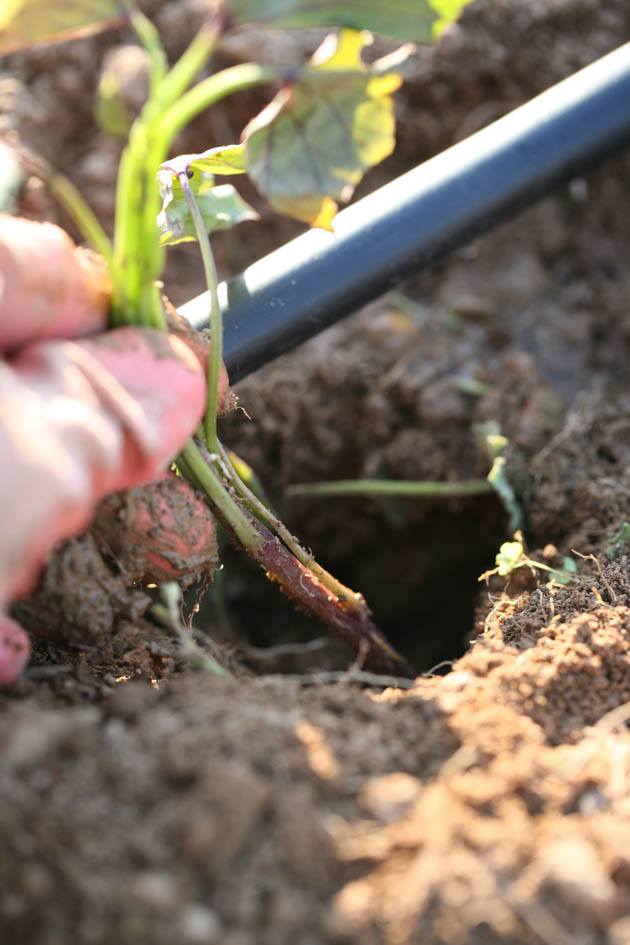Growing purple sweet potatoes is super easy and anyone can do it. You can even grow them in pots. Purple sweet potatoes are good for you, filling, and they keep well. We’ll talk about everything you need to know to grow purple sweet potatoes in this post.
Purple sweet potatoes are a bit different than the common orange sweet potatoes that we know so well.
They have a different texture (heavier and creamier) and they are not as sweet as the orange potatoes. They are very good for us (more on that later), and they are just as simple to grow as orange sweet potatoes.
I got my first purple sweet potatoes at a farmer’s market years ago. I was walking around and noticed a vegetable that I hadn’t seen before. I got curious and bought a few of them.
I didn’t mean to grow them, I simply wanted to taste them. It didn’t work when I tried to sprout a regular orange potato that year to make slips to plant in the garden. My potato grew a lot of roots but not a single slip.
If you’re interested in growing the gorgeous, antioxidant-rich purple sweet potatoes, you’re probably wondering – what growing zones can support these colorful tubers? While they thrive in tropical environments, purple sweet potatoes can actually be grown in a fairly wide range of climates if cared for properly.
Let’s explore the optimal growing zones for purple sweet potatoes, along with tips for successfully raising them in your area.
Best Zones for Growing Purple Sweet Potatoes
Purple sweet potatoes prefer hot, humid conditions much like their orange sweet potato cousins. While not cold tolerant, they can adapt to various climates with the right care:
-
Zones 8-11 – These warm zones are ideal for purple sweet potatoes. Plant slips after the last frost when soil temperatures reach 65°F.
-
Zones 6-7 – Purple sweet potatoes can grow well here, but may need season extending strategies like black plastic mulch to boost heat and soil temps. Wait until late spring to plant.
-
Zones 5 and cooler – Challenging but possible! Choose early maturing varieties and use season extending methods Start plants indoors
Growing Purple Sweet Potatoes in Cooler Zones
Gardeners in cooler climates can still succeed with purple sweet potatoes, but will need to employ some season extending techniques:
-
Start slips indoors up to 8 weeks before last frost to get plants off to an early start. Harden off before transplanting.
-
Use black plastic mulch over planting rows to warm the soil, boost growth, and reduce weeds.
-
Cover plants with fabric row covers at night if temperatures drop below 50°F.
-
Provide wind protection for young plants if cooling breezes are an issue.
-
Irrigate regularly as plants dislike drought stress in cooler conditions.
-
Choose early maturing sweet potato varieties suited to your zone’s season length.
-
Hill soil over the crowns throughout the season to boost temperatures around the tubers.
-
Harvest potatoes 1-2 weeks before first frost and cure properly to maximize storage life.
Growing Tips for Purple Sweet Potatoes in Warm Zones
Gardeners in zones 8 and warmer can more easily grow bountiful crops of purple sweet potatoes. Follow these tips:
-
Plant slips in late spring 1-2 weeks after last expected frost when soil is at least 65°F.
-
Space slips 12-15 inches apart in rows 3-4 feet apart to allow plenty of room for growth.
-
Plant in loose, well-draining and warm soil enriched with compost. Avoid heavy clay.
-
Water young plants regularly until established. Mature plants are quite drought tolerant.
-
Apply a balanced liquid fertilizer every 2-4 weeks during the growing season.
-
Remove any flowers to encourage more energy directed to the tubers.
-
Harvest potatoes carefully about 90-120 days after planting before heavy frosts arrive.
-
Cure harvested potatoes for 1-2 weeks in warm, humid conditions before long term storage.
Ideal Growing Conditions for Purple Sweet Potatoes
To achieve the highest yields of picture-perfect purple sweet potatoes, provide the following growing conditions:
-
Soil Temperature – 65°F or warmer for best growth and tuber development
-
Soil pH – 5.6 to 6.2; sweet potatoes thrive in slightly acidic conditions
-
Sunlight – Full sun is mandatory, at least 8 hours per day
-
Soil – Loose, sandy loam soil enriched with compost for drainage and nutrition
-
Water – Consistent moisture, around 1″ per week. Avoid overly wet soils.
-
Humidity – Sweet potatoes relish humidity levels above 60%
-
Air Temperature – Daytime temps of 75-85°F, nights above 60°F
-
Fertilizer – Moderate feeding with a balanced fertilizer every 2-4 weeks
Challenges Growing Purple Sweet Potatoes
While quite forgiving plants overall, a few issues may arise while raising purple sweet potatoes:
-
Insufficient heat leading to slow growth and low yields
-
Overly wet soil causing tubers to rot
-
Drought stress inhibiting leaf and root development
-
Heavy clay soil preventing proper potato formation
-
Nutrient deficiencies causing stunted vines
-
Pests like wireworms, grubs, and sweet potato weevils
-
Diseases like stem rot, scurf, pox, and leaf spot
-
Freeze damage to young plants from cold temps or frost
With preventative care, crop rotation, and prompt troubleshooting, most potential problems can be avoided.
Growing vibrant, delicious purple sweet potatoes is possible in many climates with the right variety selection and care. From the warm zones of the South to chilly Northern regions, gardeners across the country can enjoy these nutritional powerhouses!
Planting Purple Sweet Potato Slips…

Sweet potatoes can’t survive in cold temperatures. Be patient and wait until all danger of frost (even light frost) is gone. Before you plant, the temperature outside should be at least in the upper 60s or lower 70s, and the temperature of the soil should be in the 60s.
Here in zone 7b, I plant my purple sweet potatoes in mid May.
It’s super easy to plant the slips. Dig a hole that is about 6” deep, stick the slip in there and cover. That’s it.
Space your plants 12” apart and your rows 3′ apart. These vines will spread out and probably take over your walkways. If you think they are getting out of hand, feel free to cut them back a bit.
As with any transplanting, make sure to water the new plants well, and it’s always a good idea to cover them with straw to keep the soil moist and protect them from the sun. This post has more information on how to transplant seedlings.
How to Grow Purple Sweet Potatoes…
Here is what we are going to go over in this tutorial:
How to Grow Purple Sweet Potatoes | IN ZONE 6!
How do you grow purple sweet potatoes?
To grow your own purple sweet potatoes, check out the following steps: 1. Choose a site. Sweet potatoes need at least six hours of full sun a day. While they can still grow in partial shade, the crop will thrive better with direct sunlight. Choose a planting site that receives at least six hours of sunlight per day. 2. Dig your planting holes.
How long does it take to grow purple sweet potatoes?
Planting purple sweet potatoes can be challenging, as they require a long growing season (around 120 days), and consistent, hot weather. To grow your own purple sweet potatoes, check out the following steps: 1. Choose a site. Sweet potatoes need at least six hours of full sun a day.
Do sweet potatoes grow in clumps in the ground?
Sweet potatoes don’t prefer growing in soil with rocks and clumps, as it may result in oddly shaped potatoes. Typically, sweet potatoes are grown from purchased slips, but it’s also possible to root a store-bought sweet potato. Sweet potatoes aren’t finicky about the texture of the ground they grow in.
What are the different types of purple sweet potatoes?
The purple sweet potato comes in a few different varieties—Charleston, Murasaki, and Okinawan. You can prepare each variety of purple sweet potato using several methods, including boiling, baking, mashing, roasting, and frying. Root vegetables like white potatoes and sweet potatoes are not grown from seed at all but from chunks of potato.
- The Ultimate Guide to Growing Strawberries in Raised Beds - August 8, 2025
- No-Dig Garden Beds: The Easiest Way to Grow a Beautiful Garden - August 6, 2025
- How to Protect and Preserve Wood for Raised Garden Beds - August 6, 2025

